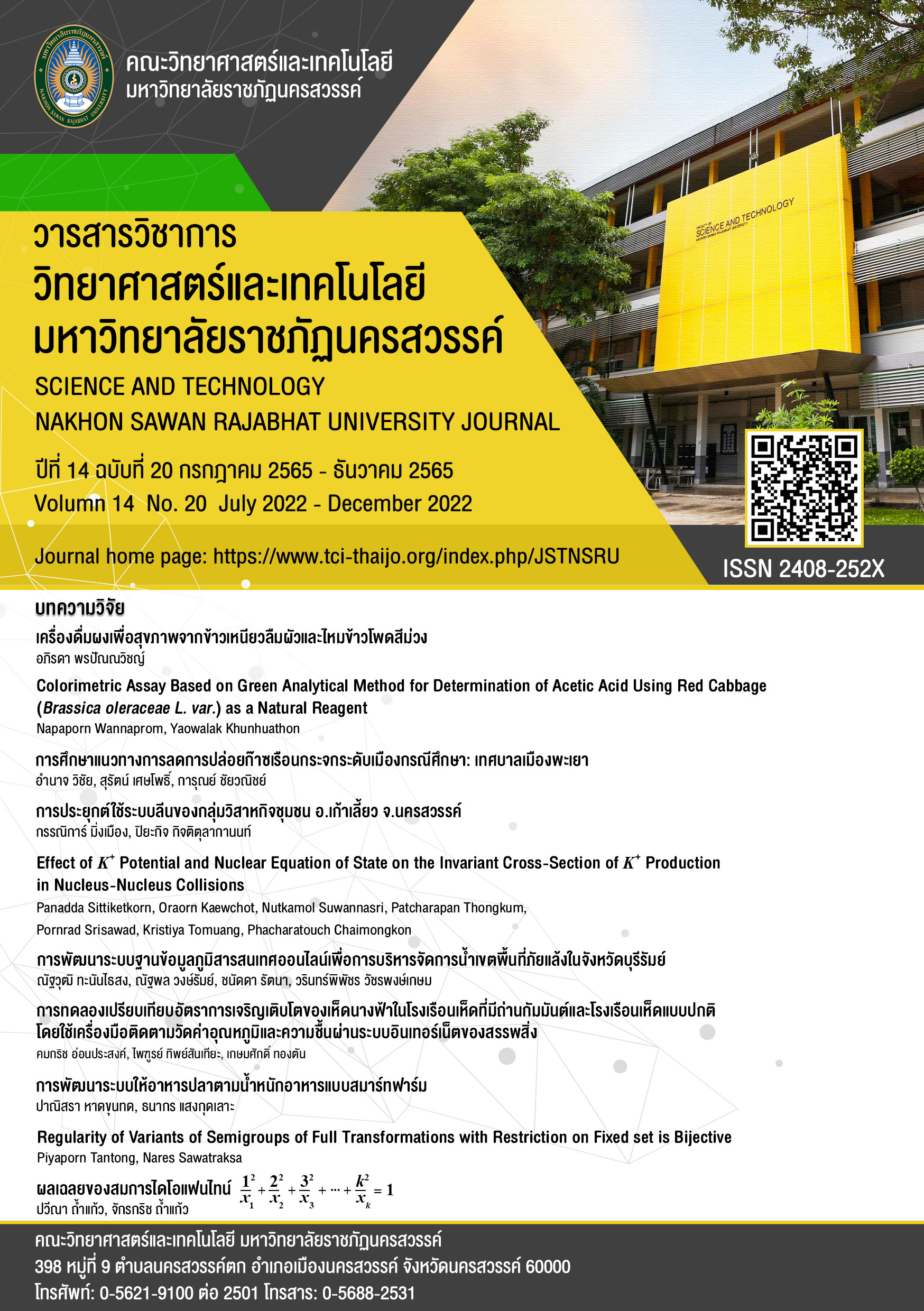Effect of K+ Potential and Nuclear Equation of State on the Invariant Cross-Section of K+ Production in Nucleus-Nucleus Collisions
Main Article Content
Abstract
This work examines and concentrates on the effect of K+ potential and nuclear equation of state on the invariant cross-section of K+ production in nucleus-nucleus collisions. The invariant cross-section of K+ production as a function of kinetic energy in heavy-ion collisions at incident energy 0.8 and 1.0 A GeV (GeV/Nucleon) in 12C + 12C collisions with impact parameter between 3.70 and 5.73 fm by using the quantum molecular dynamics model (QMD) is studied. The calculations energized with and without the Brown-Rho parameters (K+N potential) as well as the soft and hard equation of state (soft and hard EOS). In addition, the invariant cross-section of K+ production as a function of kinetic energy is computed and compared with KaoS experiments. The results show that K+ production is measured by utilizing the QMD model with a soft EoS, which similar to a hard EoS. The theoretical calculations with soft and hard EoS while expanding the K+N potential tend to be consistent with the KaoS experiments, Consequently, this work refers that the invariant cross-section of K+ production in heavy-ion collision at intermediate is sensitive observable to probe the nuclear equation of state in dense nuclear matter.
Article Details

This work is licensed under a Creative Commons Attribution-NonCommercial-NoDerivatives 4.0 International License.
References
Aichelin, A., Rosenhauer, G., Peilert, H., Stöcker, H., & Greiner, W. (1987). Importance of Momentum-Dependent Interactions for the Extraction of the Nuclear Equation of State from High-Energy Heavy-Ion Collisions. Physical Review Letters, 58(19), 1926-1929. https://doi.org/10.1103/PhysRevLett.58.1926
Aichelin, J., & Stöcker, H. (1986). Quantum molecular dynamics — A novel approach to N-body correlations in heavy ion collisions. Physics Letters B ,176(1-2), 14-19. https://doi.org/10.1016/0370-2693(86)90916-0
Aichelin, J. (1991). “Quantum” molecular dynamics—a dynamical microscopic n-body approach to investigate fragment formation and the nuclear equation of state in heavy ion collisions. Physics Reports, 202(5-6), 233-360. https://doi.org/10.1016/0370-1573(91)90094-3
Bhalerao, R S., Borghini, N. & Ollitraultb, J Y. (2003). Analysis of anisotropic flow with Lee–Yang zeroes. Nuclear Physics A, 727(3-4), 373-426. https://doi.org/10.1016/j.nuclphysa.2003.08.007
Brown, G E., Buballa, M., & Rho, M. (1996). A mean-field theory of the chiral phase transition. Nuclear Physics A, 609(4), 519-536. https://doi.org/10.1016/S0375-9474(96)00295-3
Chaimongkon, P. et al. (2019). Azimuthal emission patterns of proton in 58Ni + 58Ni collision at intermediate energy by using a quantum molecular dynamics model. Journal of Physics: Conference Series. 1380, 012009. https://doi.org/10.1088/1742-6596/1380/1/012009
Chaimongkon, P. et al. (2019). Elliptic flow of the proton in 197Au + 197Au collisions reaction at intermediate energy by using a quantum molecular dynamics model. Journal of Physics: Conference Series, 1380, 012008. https://doi.org/10.1088/1742-6596/1380/1/012008
Chaimongkon, P. et al. (2019). The effect of K+potential on the nuclear equation of state for the K+ production in heavy ion collisions by using a quantum molecular dynamics model. Journal of Physics: Conference Series, 1380, 012011. https://doi.org/10.1088/ 1742-6596/1380/1/012011
Fuchs, C., Faessler, A., Zabrodin, E., & Zheng, Y M. (2001). Probing the Nuclear Equation of State by K+ Production in Heavy-Ion Collisions. Physical Review Letters, 86(10), 1974-1977. https://doi.org/10.1103/PhysRevLett.86.1974
Fuchs, C. et al. (1999). Chiral kaon dynamics in heavy ion collisions. Progress in Particle and Nuclear Physics, 42 : 197-206. https://doi.org/10.1016/S0146-6410(99)00074-5
Fuchs, C. (2006). Kaon production in heavy ion reactions at intermediate energies. Progress in Particle and Nuclear Physics, 56(1), 1-103. https://doi.org/10.1016/j.ppnp.2005.07.004
Hartnack, C. (2004). Dynamics of K+ Production in Heavy Ion Collisions close to Threshold. Thesis of Habilitation, Nantes University, nuclth/0507002.
Hartnack, C., Jaenicke, J., Sehn, L., Stöcker, H., and Aichelin, J. (1994). Kaon production at subthreshold energies. Nuclear Physics A, 580(4), 643-677. https://doi.org/10.1016/ 0375-9474(94)90786-2
Hartnack, C., Oeschler, H., & Aichelin, J. (2006). Hadronic Matter Is Soft. Physical Review Letters, 96(1), 012302. https://doi.org/10.1103/PhysRevLett.96.012302
Hartnack, C., Oeschler, H., Leifels, Y., Bratkovskaya, E L., & Aichelin, J. (2012). Strangeness production close to threshold in proton-nucleus and heavy-ion collisions. Physics Reports, 510(4-5), 119-200. https://doi.org/10.1016/j.physrep.2011.08.004
Hartnack, C., Puri, R., & Aichelin, J. et al. (1998). Modelling the many-body dynamics of heavy ion collisions: Present status and future perspective. The European Physical Journal A - Hadrons and Nuclei, 1, 151–169. https://doi.org/10.1007/s100500050045
Ko, C M. (1984). Effect of final state interactions on subthreshold K− production in heavy-ion collisions. Physics Letters B, 138(5-6), 361-364. https://doi.org/10.1016/0370-2693(84)91917-8
Ko, C M. (2001). Medium effects on the flow of strange particles in heavy-ion collisions. Journal of Physics G: Nuclear and Particle Physics, 27, 327. https://iopscience.iop.org/article/10.1088/ 0954-3899/27/3/310
Li, G Q., Ko, C M., & Li, Bao-An. (1995). Enhancement of Low-Mass Dileptons in Heavy Ion Collisions. Physical Review Letters, 75(22), 4007-4010. https://doi.org/10.1103/PhysRevLett.75.4007
Li, Q G., and Ko, C M. (1995). Kaon flow in heavy-ion collisions. Nuclear Physics A, 594(4), 460-482. https://doi.org/10.1016/0375-9474(95)00377-D
Maruyama T., Ohnishi A., & Horiuchi H. (1990). Quantum molecular dynamics study of fusion and its fade out in the 16O +16O system. Physical Review C, 42(1), 386-394. https://doi.org/10.1103/PhysRevC.42.386
Oeschler, H. (2006). Kaon production in heavy ion collisions — Which observable is best suited to observe in-medium potentials. Acta Physica Hungarica A, 27, 175–185. https://doi.org/10.1007/BF03177672
Oyamatsu, K., & Sumiyoshi, K. (1998). Neutrino-nucleus interactions and supernova modeling.
Nuclear Physics B - Proceedings Supplements, 159, 27-32. https://doi.org/10.1016/ j.nuclphysbps.2006.08.024
Srisawad, P. et al. (2018). Effect of the K+ in-medium potential on K+ production in heavy ion collisions. Journal of Physics: Conference Series, 1144, 012102. https://doi.org/10.1088/ 1742-6596/1144/1/012102
Zheng, Y M., Fuchs, C., Faessler, A., Shekhter, K., Yan, Y., and Kobdaj, C. (2004). Covariant kaon dynamics and kaon flow in heavy ion collisions. Physical Review C, 69, 034907. https://doi.org/10.1103/PhysRevC.69.034907


